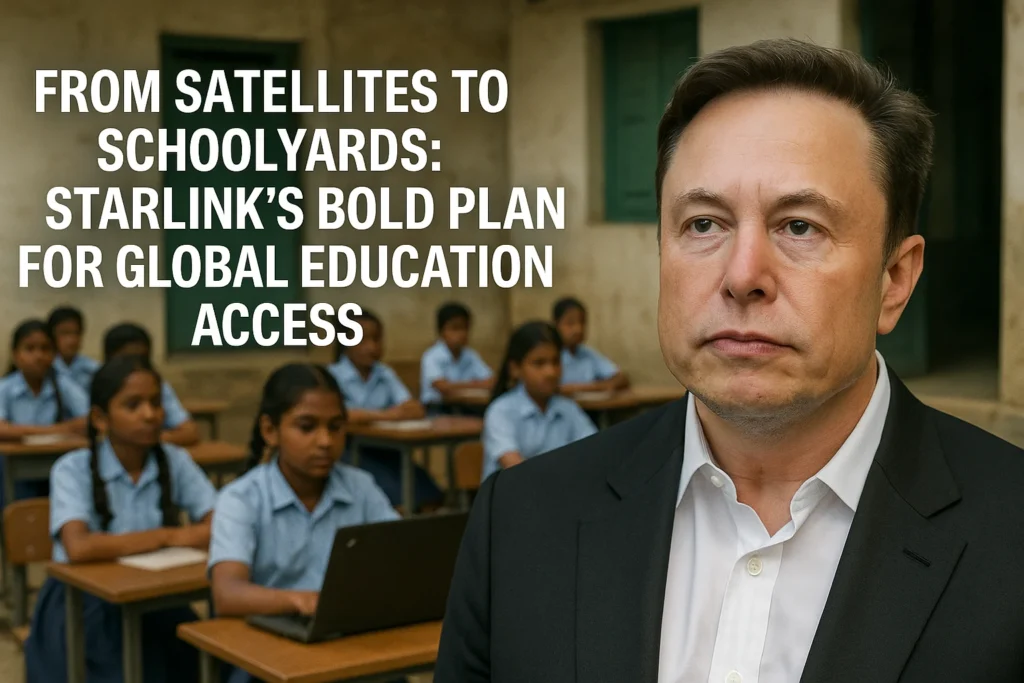In the vast tapestry of global connectivity, millions of children remain on the fringes, their access to education limited by the absence of a fundamental modern tool: the internet. While classrooms in urban centers buzz with digital learning, remote villages across Africa and South Asia often stare at blank walls, disconnected from a world of knowledge. Enter Elon Musk’s SpaceX and its ambitious Starlink project, a constellation of satellites designed to beam high-speed internet from low Earth orbit to every corner of the planet. While the dream of universal, free Starlink for every school remains a vision, the company’s engagements with governments in these regions are beginning to paint a picture of how satellites could indeed bring schoolyards into the digital age.
This isn’t just a story about technology; it’s about bridging the global digital divide, unlocking human potential, and rethinking how education can be delivered in even the most challenging environments. From promising proposals in South Africa to pilot programs in Rwanda, Starlink is taking steps, big and small, to connect the unconnected, proving that the future of learning might just be orbiting above our heads.
The Digital Divide: A Barrier to Learning
For generations, the quality of education has often been tied to geographical location. Urban centers, with their robust infrastructure, have long enjoyed access to resources—libraries, highly trained teachers, and more recently, high-speed internet. But for communities in remote, rural areas, particularly across vast swathes of Africa and South Asia, the reality is starkly different.
- Limited Infrastructure: Laying fiber optic cables or building cell towers in challenging terrains, dense forests, or sparsely populated deserts is incredibly expensive and often impractical for traditional internet providers.
- Affordability: Even where some form of connectivity exists, the cost can be prohibitive for public schools or low-income families.
- Access to Resources: Without internet, students lack access to online textbooks, educational videos, virtual labs, and collaborative tools that are becoming standard in connected classrooms globally. Teachers miss out on professional development opportunities and up-to-date curricula.
- Economic Disadvantage: This digital exclusion perpetuates a cycle of disadvantage, limiting opportunities for students to develop crucial digital literacy skills needed for the modern workforce.
The scale of this challenge is immense. Hundreds of thousands of schools remain offline, impacting millions of children. Bridging this gap is not merely a technological problem but a humanitarian imperative, essential for achieving global education goals and fostering equitable development. This is where satellite internet, with its ability to bypass terrestrial infrastructure, steps in as a potential game-changer.
From Orbit to Opportunity: Starlink’s Unique Proposition
Starlink, operated by Elon Musk’s SpaceX, is designed to tackle the very problem of connectivity in hard-to-reach areas. Unlike traditional geostationary satellites that orbit far from Earth, Starlink utilizes a massive constellation of thousands of smaller satellites in Low Earth Orbit (LEO). This fundamental difference brings several key advantages for internet connectivity:
- Low Latency (Fast Speeds): Because LEO satellites are much closer to Earth (around 550 km compared to 36,000 km for geostationary satellites), the signal travel time (latency) is significantly reduced. This means faster, more responsive internet, crucial for real-time applications like video conferencing for online classes or interactive learning platforms.
- Global Coverage: A sufficiently large LEO constellation can provide near-global coverage, reaching areas that are impossible or uneconomical for fiber optic cables or cellular towers. This includes remote villages, islands, and even disaster zones.
- Rapid Deployment: Setting up Starlink involves deploying a compact “Dishy” terminal and connecting it to a power source. This makes it relatively quick to deploy in locations where traditional infrastructure would take years and massive investment.
- High Bandwidth Potential: While individual user speeds vary, the overall network is designed to handle significant data traffic, supporting multiple users in a school environment.
These characteristics make Starlink particularly appealing for school connectivity in regions with underdeveloped terrestrial infrastructure. It offers a promise of high-speed, reliable internet that can literally be dropped into a schoolyard, transforming it into a hub of digital learning.
South Africa’s Bold Proposal: 5,000 Schools Connected?
In a significant development that underscores Starlink’s potential role in education, SpaceX has put forth a substantial proposal to the government of South Africa. As of June 2025, Starlink has pledged to provide “fully funded Starlink kits and service” to over 5,000 rural schools across the country. This ambitious initiative is part of Starlink’s strategy to meet local regulatory requirements related to “equity equivalent investment programs” (EEIPs).
The proposal, communicated in a letter to South African officials, aims to address the country’s Broad-Based Black Economic Empowerment (B-BBEE) policies, which typically require a percentage of local ownership for companies operating in the telecommunications sector. Starlink, due to its global operational model, typically maintains sole ownership of its subsidiaries. By proposing a large-scale, free connectivity program for schools, Starlink aims to demonstrate a significant socio-economic contribution that aligns with the spirit of the B-BBEE legislation.
If approved, this partnership could:
- Impact Millions of Students: With 5,000 schools potentially getting free internet, an estimated 2.4 million children could gain access to online educational resources each year.
- Bridge Rural Divide: It would directly target rural schools, bringing high-speed internet to areas that have historically been left behind by traditional broadband providers.
- Facilitate Digital Learning: Teachers and students would have the tools to access e-learning platforms, conduct research, and develop digital skills essential for the 21st century.
While the final approval and implementation details are still under discussion, this proposal highlights a potential model for large-scale, impactful partnerships between Starlink and governments in developing regions, turning regulatory hurdles into opportunities for social good.
Pilot Programs and Partnerships: Spreading Connectivity
Beyond the ambitious proposal in South Africa, Starlink has already engaged in pilot programs and partnerships that demonstrate its commitment to expanding educational access in underserved areas globally, including in Africa and other developing regions.
One notable example is the deployment in Rwanda. In July 2023, as part of the Rwandan government’s “School Connectivity Program,” Starlink deployed internet services in 50 schools across rural parts of the country. This pilot, a collaboration between the Rwandan Ministry of ICT and Innovation, Starlink, and with support from former UK Prime Minister Tony Blair’s foundation, marked a crucial step in Rwanda’s efforts to ensure internet access for all schoolchildren. The initial phase focused on leveraging satellite technology to reach areas where conventional connectivity was absent, offering more than 18,000 students access to online courses and improved learning opportunities.
Similarly, in Sierra Leone, the government has partnered with Starlink (via its local representative, ELCOME SL Ltd.) to expand internet access to public and private universities. While not exclusively focused on primary or secondary schools, this initiative aims to enhance digital access for students and aligns with the country’s National Broadband Strategy. There are also plans to extend connectivity to vocational schools in subsequent phases, demonstrating a broader vision for digital education infrastructure.
These examples illustrate that while a sweeping, globally uniform “free Starlink for all schools” announcement by Elon Musk has not occurred, the company is actively engaging with specific governments and organizations to address educational connectivity needs. These partnerships often involve a mix of government initiatives, philanthropic contributions, and Starlink’s technology, creating tailored solutions for various regional contexts.
South Asia’s Digital Horizon: Starlink’s Commercial Impact
In South Asia, particularly in countries like India and Bangladesh, Starlink’s primary entry strategy has been through commercial rollout, but its presence inherently holds immense promise for education, especially in remote areas.
India, a nation with a massive and growing internet user base, has seen Starlink gain crucial licenses in June 2025. While pricing for consumers (device around ₹33,000 and monthly plans around ₹3,000) has been announced, Starlink’s ability to provide high-speed internet to areas where traditional broadband infrastructure is non-existent or unreliable is a game-changer. This means that even without a specific “free schools” program (outside of perhaps future localized CSR initiatives), schools in underserved parts of India could gain access to vital connectivity by leveraging commercial services or through government subsidies that emerge from Starlink’s operational presence. The sheer scale of India’s rural population means that any viable high-speed internet option can profoundly impact educational institutions outside major cities.
In Bangladesh, Starlink has also secured agreements to set up ground stations. The country’s unique geography, with many remote or flood-prone areas, makes satellite internet an ideal solution for consistent connectivity. As Starlink expands its commercial services, it creates the underlying infrastructure that can then be leveraged by schools, NGOs, and local governments to bring digital learning to communities that have been historically isolated.
The narrative in South Asia isn’t necessarily about free access provided directly by Starlink, but rather about the fundamental availability of robust internet where it was previously impossible. This accessibility, combined with government initiatives to subsidize educational internet or provide devices, could unlock immense potential for digital learning across the subcontinent.
Beyond Connectivity: Powering the Digital Classroom
Providing internet access is the crucial first step, but the true transformation of education lies in how that connectivity is utilized. Starlink’s high-speed, low-latency internet opens doors to a multitude of digital learning opportunities:
- Access to Online Content: Students and teachers can download e-books, stream educational videos, access online libraries, and use interactive learning applications from anywhere. This vastly expands the curriculum beyond traditional textbooks.
- Virtual Classrooms and Remote Learning: In areas where qualified teachers might be scarce, Starlink can enable remote teaching, allowing students to learn from instructors located hundreds or thousands of miles away. It also facilitates continued education during school closures due to natural disasters or other emergencies.
- Teacher Training and Professional Development: Educators in remote areas can access online courses, workshops, and collaborative platforms to enhance their skills and stay updated with the latest pedagogical techniques.
- Digital Literacy Skills: Direct internet access helps students develop essential digital literacy skills – navigating the web, critical evaluation of information, and digital communication – which are vital for future employment.
- Global Collaboration: Schools can connect with classrooms in other parts of the world, fostering cultural exchange and a broader understanding of global issues.
- Data-Driven Education: Connectivity allows for the use of educational management systems to track student progress, identify learning gaps, and tailor instruction more effectively.
The promise of Starlink isn’t just about bringing the internet to schools; it’s about bringing the entire digital world into the classroom, democratizing access to knowledge and equipping a new generation with the tools they need to thrive in a connected future.
Navigating the Challenges on the Ground
Despite its immense promise and ongoing efforts, Starlink’s widespread adoption for educational purposes, particularly free initiatives, faces several practical challenges:
- Cost of Hardware and Subscriptions: While there are specific programs and proposals for free service (like in South Africa), Starlink’s standard service involves a significant upfront cost for the satellite dish and a monthly subscription fee. For public schools or governments in low-income regions, even if subsidized, scaling this across tens of thousands of schools can be financially daunting.
- Power Supply: Starlink terminals require a stable power supply. In many rural and remote areas of Africa and South Asia, electricity access is intermittent or non-existent. This necessitates additional investment in solar power solutions or reliable generators.
- Internal School Infrastructure: Even with internet reaching the school, distributing it effectively within classrooms requires internal Wi-Fi networks, computers, tablets, or other devices. Many schools lack these basic IT infrastructures.
- Digital Literacy Training: Providing internet access is not enough. Teachers and students need training on how to use digital tools effectively, integrate online resources into lessons, and practice safe online habits.
- Regulatory Hurdles: Starlink often faces complex regulatory landscapes in new countries, including licensing requirements, spectrum allocation, and data privacy laws, as seen in the ongoing discussions in South Africa regarding equity laws.
- Local Competition and Partnerships: Starlink must navigate existing telecommunications markets and potentially partner with local providers to ensure successful and sustainable deployment, as is being explored in India with major telecom players.
Addressing these challenges requires a multi-pronged approach involving governments, private sector partners, NGOs, and local communities, ensuring that the technology is not just delivered but effectively integrated into the educational ecosystem.
Looking Ahead: Starlink’s Role in a Connected Future
Starlink’s journey in connecting schools in Africa and South Asia is a compelling case study in leveraging cutting-edge space technology for global development. While a universal “free Starlink for schools” announcement covering entire continents hasn’t materialized from Elon Musk, the ongoing collaborations, pilot programs, and significant proposals demonstrate a clear path toward bridging the digital divide in education.
The South African proposal to connect 5,000 rural schools, contingent on regulatory agreement, represents a potential breakthrough in large-scale, funded connectivity. Similarly, existing deployments in Rwanda and partnerships in Sierra Leone and Jamaica show a growing trend of governments recognizing Starlink’s unique ability to serve underserved areas. In South Asia, Starlink’s commercial rollout, while not “free,” opens the door for widespread access that can be leveraged for educational purposes through various funding models.
The future of global education depends heavily on equitable access to information and digital tools. As Starlink continues to expand its satellite constellation and refine its partnerships, it stands poised to play a crucial role in ensuring that “from satellites to schoolyards,” no child is left behind in the race for a connected, knowledge-rich future. The full impact of this bold plan is still unfolding, but its potential to transform lives and learning across continents is undeniable.



